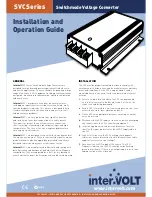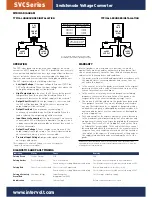
www.intervolt.com
SVC SERIES – SWITCHMODE VOLTAGE CONVERTER – INSTALLATION AND OPERATION GUIDE
Switchmode Voltage Converter
SVC Series
GENERAL
Intervolt
SVC Series Switchmode Voltage Converters are
designed for high demand power requirements in both vessel
and vehicle applications. They are suitable for powering a large
range of auxiliary 12 VDC equipment including communications,
navigation, monitoring, instrumentation, lighting, refrigeration
and much more.
Intervolt
SVC’s incorporate a range of innovative features
including an industry first micro-processor controlled, multi-
function diagnostic indicator. This feature is designed to help
trouble-shoot general installation errors and assist in fault
finding common problems.
Intervolt
SVC’s are fully protected from typical connection
and installation faults by a range of built-in safety devices.
These devices protect the units from reverse connection,
short-circuiting, overloading, high output voltages and high
temperatures. The case of the unit is ungrounded therefore
ensuring electrical isolation.
Intervolt
SVC’s are designed to cope with the harsh demands of
the marine environment. They are constructed of quality marine
grade materials and when applied and installed correctly are
designed to provide many years of continuous service.
Intervolt
SVC’s are manufactured in Australia and comply with
both Australian and European Standards for Electro-Magnetic
compatibility. They are supported by a 100% factory backed 24
month warranty against faulty components and/or workmanship.
INSTALLATION
The SVC must be properly mounted in order to comply with
environmental considerations and the manufacturer’s warranty
terms and conditions. As the SVC is ungrounded it can be
mounted directly to any metal surface and maintain electrical
isolation.
1.
Select a suitable location where the SVC can be mounted
on a vertical surface (i.e. bulkhead, firewall, etc.) with the
connection end facing downward .
2.
Ensure SVC is located in a well ventilated position, free from
excessive moisture, dust, vibration and heat.
3.
Fix the SVC with appropriate fasteners ensuring all anchor
holes are utilised.
4.
Disconnect the 24VDC supply at the source before attempting
any connection to the SVC or auxiliary equipment.
5.
Install an appropriately rated circuit breaker or fuse (see
chart) as the input protection for the 24VDC supply cable to
the SVC.
6.
Connect all circuits to the SVC ensuring that adequate
cable sizes are used for model installed (consult your cable
supplier for correct current ratings).
7.
Reconnect the 24VDC supply at the source. The LED
Diagnostic Indicator on the SVC should now be flashing
green intermittently. If there is no output supply refer to fault
finding section at rear of booklet.
Installation and
Operation Guide




















